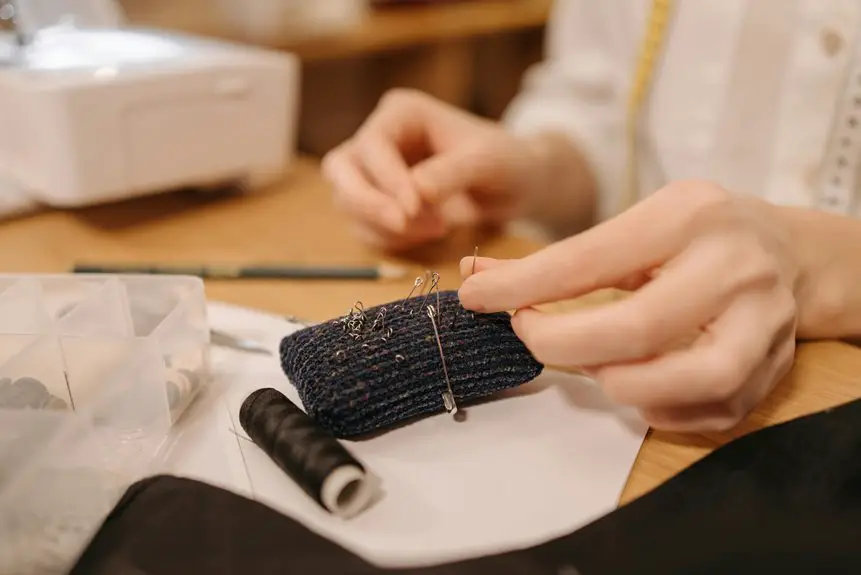You can revive old garments by patching tears or worn spots with lightweight gauze fabric, which adds softness and breathability without bulk. Choose gauze that matches your garment’s weight and color to blend or contrast creatively. Cut patches slightly larger than holes, then sew or glue them in place for durable, stylish repairs. With simple techniques and creative touches, you’ll give your clothes new life and unique flair. Keep exploring for helpful tips and design ideas.
Table of Contents
Key Takeaways
- Use lightweight, breathable gauze fabric to repair worn or damaged areas without compromising garment comfort and flexibility.
- Select gauze patches that complement the garment’s color, texture, and weight for seamless or artistic repair effects.
- Prepare gauze patches by washing and ironing, then secure and sew them carefully for durable, neat patchwork.
- Enhance visual appeal by layering gauze textures, using bold contrasts, or adding embroidery and fabric paint accents.
- Maintain patched garments with gentle hand washing, cold water, air drying, and low-heat ironing to preserve fabric integrity.
Benefits of Using Gauze Fabric for Garment Repair
Gauze fabric offers unique advantages when you repair old garments. Its lightweight, breathable texture makes it ideal for mending worn areas without adding bulk.
When you patch holes or tears with gauze, you maintain comfort, especially on delicate clothes. The loosely woven fibers allow your garment to remain flexible and soft, preventing stiffness that heavier fabrics cause.
You’ll also appreciate how gauze blends well with various materials, creating subtle repairs that don’t stand out. Plus, it’s easy to handle and sew, making your repair process quicker and less frustrating.
Using gauze fabric means your garment stays wearable and comfortable while extending its life, all without compromising style or function. It’s a smart choice for thoughtful, effective garment restoration.
Choosing the Right Gauze Fabric for Your Project
How do you pick the best fabric to breathe new life into your worn garments? Start by considering the weight and texture of the gauze. You want a fabric that complements the original garment without overwhelming it.
Lightweight gauze works well for delicate fabrics, while a slightly sturdier gauze suits heavier materials. Next, think about color and pattern—choose tones that harmonize or create a deliberate contrast to highlight your patchwork.
Also, check the fabric’s weave and softness to guarantee it feels comfortable against your skin. Finally, measure the size of your patches carefully, so you don’t run short of fabric mid-project.
Techniques for Applying Patchwork Gauze to Clothing
Once you’ve selected your gauze fabric, you’ll need to prepare both the patches and the garment for a seamless application. Start by washing and ironing the gauze to prevent future shrinkage.
Cut your patches slightly larger than the damaged areas or spots you want to cover. Next, position the patches on the garment and secure them with pins or fabric glue for stability.
When applying the patches, choose between hand stitching or machine sewing. For a subtle finish, use a narrow zigzag stitch along the edges, ensuring the gauze lies flat without puckering. If you prefer handwork, a whipstitch works well, blending the patch smoothly.
Finally, press the garment gently to set the patch, and you’re ready to wear your refreshed piece with confidence.
Creative Design Ideas With Patchwork Gauze
While patchwork gauze is perfect for repairs, it also offers endless opportunities to elevate your garments with unique designs. You can create bold contrasts by mixing colorful gauze patches on neutral fabric, turning a simple shirt or jeans into a statement piece.
Try layering different gauze textures for a dimensional, tactile effect. Adding asymmetrical patch placements draws the eye and breaks monotony. You might also experiment with geometric shapes—triangles, squares, or circles—to give your garment a modern, artistic flair.
Don’t hesitate to combine patchwork gauze with embroidery or fabric paint for personalized accents. By thinking beyond mere mending, you transform old clothes into wearable art that reflects your style while embracing sustainability.
Let your creativity lead the way and watch your wardrobe come alive.
Caring for Garments Enhanced With Gauze Patches
Caring for garments enhanced with gauze patches requires a gentle touch to preserve both the fabric and the patchwork’s texture. You should always hand wash these items in cold water with a mild detergent to avoid damaging the delicate gauze. Avoid wringing or twisting; instead, gently press out excess water. Air drying flat prevents distortion of the patches. When ironing, use a low heat setting and place a cloth between the iron and the fabric to protect the gauze.
| Care Step | Method | Tip |
|---|---|---|
| Washing | Hand wash cold | Use mild detergent |
| Drying | Air dry flat | Avoid direct sunlight |
| Ironing | Low heat | Use a pressing cloth |
| Storing | Fold gently | Keep away from sharp objects |
| Spot Cleaning | Mild soap & water | Dab, don’t rub |
Frequently Asked Questions
Where Can I Buy Patchwork Gauze Fabric Online?
You can buy patchwork gauze fabric online at Etsy, Amazon, and specialty fabric stores like Fabric.com or Mood Fabrics. These sites offer diverse patterns and textures, making it easy for you to find the perfect gauze fabric.
Can Patchwork Gauze Be Used on Upholstery?
You can use patchwork gauze on upholstery, but keep in mind it’s lightweight and delicate. You’ll want to reinforce it with a sturdier backing or use it on low-traffic pieces to avoid wear and tear.
Is Patchwork Gauze Suitable for Children’s Clothing?
You know how Goldilocks sought the perfect fit? Patchwork gauze is just right for children’s clothing—soft, breathable, and gentle on skin. Just watch for durability and washing instructions to keep it cozy and safe.
How Long Does Patchwork Gauze Fabric Typically Last?
You’ll find patchwork gauze fabric typically lasts several years with proper care. Its durability depends on fabric quality and washing habits. Gentle washing and air drying will help you extend its lifespan considerably.
Are There Eco-Friendly Gauze Fabric Options Available?
You’ll find eco-friendly gauze fabric options made from organic cotton, bamboo, and hemp. These sustainable materials minimize environmental impact, so you can confidently choose fabrics that support eco-conscious practices while enjoying soft, breathable textures.
- Tetron Fabric for Marine Applications: Durability and Use Cases - June 18, 2025
- Tetron Fabric for Outdoor Furniture: Weather Resistance and Care - June 18, 2025
- Tetron Fabric for Wall Coverings: Style and Application Tips - June 18, 2025







